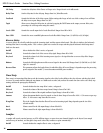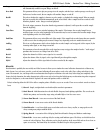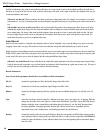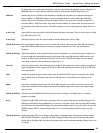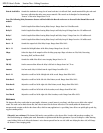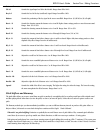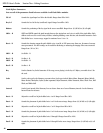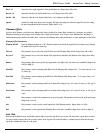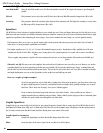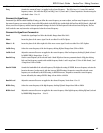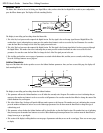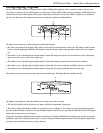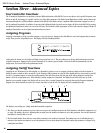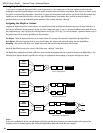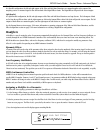
Auto Wah Effect Parameters
Auto Wah On/Off Turns the Auto Wah module on or off. When the module is turned off, the signal will continue to pass through the
module.
FX Level This parameter lets you select the overall FX level mix of the Auto Wah Effect module. Ranges from: Off to 100%.
Sensitivity This parameter adjusts the sensitivity of the detection of the automatic wah. The higher the sensitivity is set, the wider
the Wah range will be. Ranges from: Off to 100%.
Equalizers
The RP21D has a broad selection of equalizer Modules to cover virtually any need. If you need bigger Guitar tone, the EQs will give it to you.
Both mono and stereo modules are available. Remember that mono equalizers connected to stereo sources will always sum the stereo signal
together for equalization (thus eliminating the stereo image). If you need to maintain the stereo image, use a stereo equalizer module.
The Parametrics allow you to cover very specific regions of the sound spectrum with extreme precision and control. Up to 6 bands of
either stereo, or mono parametric equalization are available.
The Graphic equalizers use 1/3, 2/3, or 1 2/3 octave ISO-standard frequency centers. Equalization or EQ is probably one of the most
valuable tools the RP-20 Valve offers. EQ allows you to change the level of certain frequencies of a sound, and it comes in two different
basic
flavors: graphic and parametric. Graphic is the most common and easiest to use, but the parametric offers much more flexibility and
power.
When do I use EQ? This may seem overly simplistic, but you should use EQ whenever your ears tell you to use it! However, you need to
remember that EQ can do more harm than good when not used carefully. The EQ can take that thin and “Clangy” sounding Guitar and
add all of the low end in the world that your heart may desire. This can also be used on the other side. If you have a song that needs tight
and bright rhythm guitar, you can use the EQ modules to take out the Lows and build up your mids
Here are a couple of simple examples:
If you feel your guitar tone is just a little dull, try cutting some of the lower frequencies, you always have to boost up
the guitar’s' high frequencies, because it could quickly become too bright. Often, good EQ techniques use cut more
than boost. This is where the old saying “less is more” definitely applies.
If you are having a hard time being heard in the mix, don't make it louder. Listen carefully and see if there is
another instrument that is conflicting with your Guitar. Adding a little EQ in the right spot of the less dominant guitar
will allow it to speak a little easier through the rest of the music.
Graphic Equalizers
Graphic EQs give you control of the levels for fixed or pre-selected frequencies (bands) that are evenly spaced. The RP21D offers 8 and 15
band Mono and 8-band Stereo GEQs and a 31 band mono GEQ. They all cover the complete range of frequencies, but the spacing between
the 31 bands is much closer than the 8 bands, therefore offering more exact control of the sound.
Graphic Equalizer Parameters
Level Controls the signal input level fed to the Module. Ranges from Off to 100%.
Phase Inverts the phase of the source signal. Can be set either IN or OUT of phase.
44
RP21D User’s Guide Section Two - Editing Functions



